Central America has been exceeding our budget expectations, and Mexico has been no exception. Arriving by bus to Tulum, we decide to skip the £7 taxi for the final distance to our next accommodation, and make the 40 minute walk with all our bags (plus another food bag) to our next accommodation. We’ll be eating in whilst here, so have taken as much as we can to eat in. This does mean James is extra laden down with food. Every ‘peso‘ counts (‘peso’ being the currency here, but also meaning weight). We make it there, keeping strong and steady, proving we’ve not lost all our strength and stamina just yet. True backpacking life!
We had high expectations for our next accommodation and it doesn’t disappoint. It’s a brutalist new-build with macrame and dusky pink accessories to soften the cold of the concrete. Not only is the decor totally ‘a la mode’, we have our own private pool on our balcony and a view of the trees. Less backpacking life! The jacuzzi pool turns out to be very much more pool than jacuzzi as it has no heating element, and with Tulum being even cooler than Bacalar, we actually would have appreciated some heat for the first time in a while! That being said, it’s really nice not to be sweating all the time.

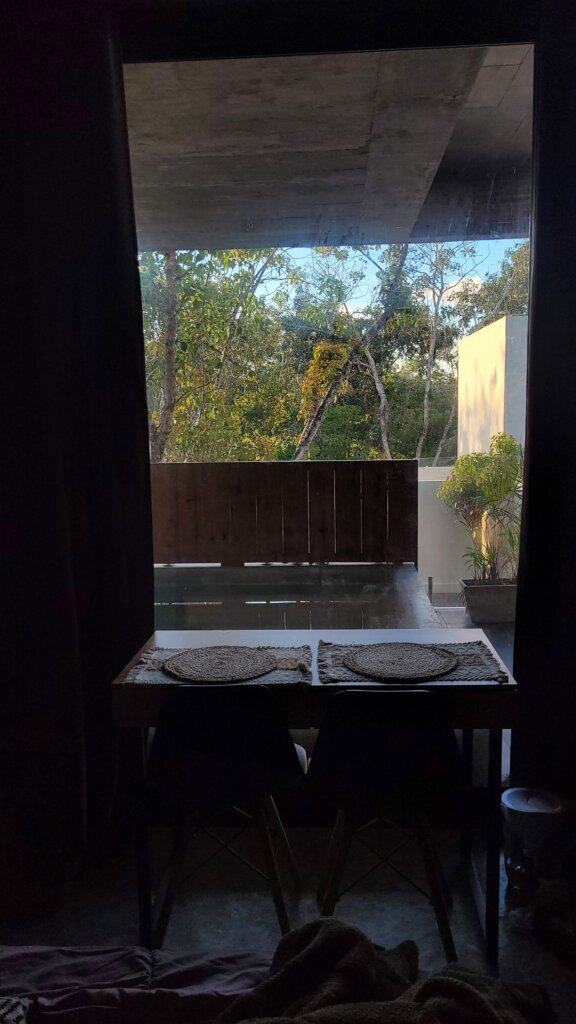
This does make dips in the pool somewhat shorter than we’d imagined, but it doesn’t stop us practicing deep breathing, cold water plunges, and paddling my feet whilst reading my book, with the moon beside me, and beer to the other side. The moon in this case being a 3d-printed portable moon which I want to take with us, but also the bright full moon and stars shining down through the trees that still surround the property.

We’re staying a bit of a way out of town as the compromise on the accommodation, but we have fixie bikes to get us around the area. We decide to tick off the main attraction in Tulum the next day, the archaelogical site.
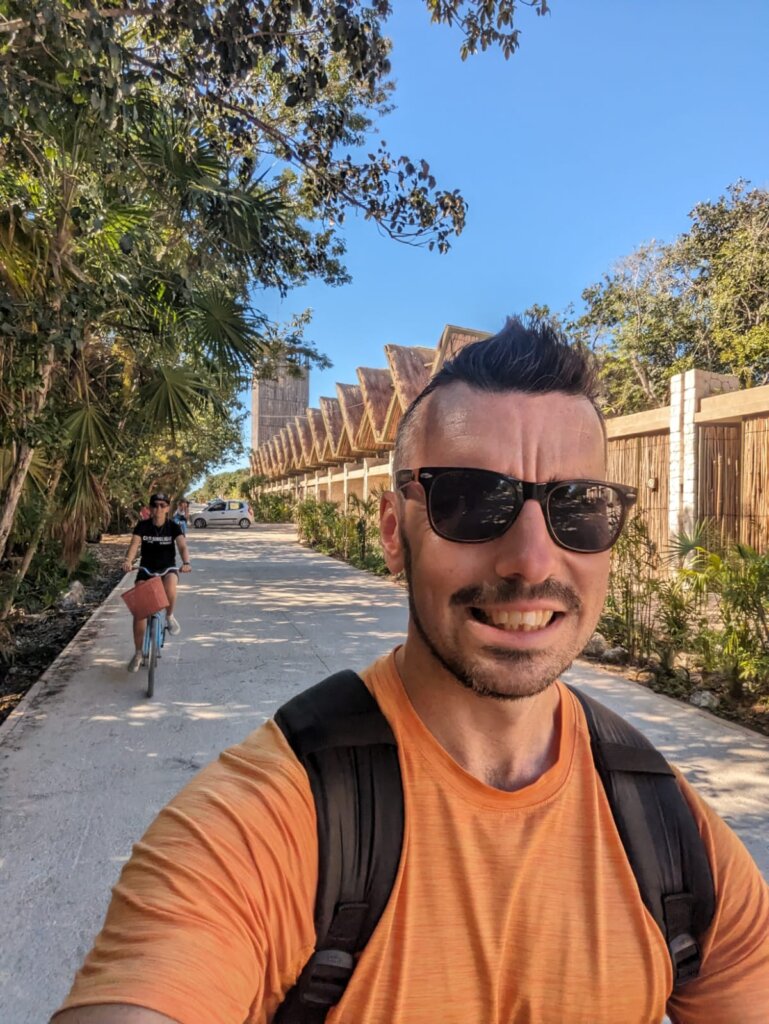
Tulum Archaeological Site
We’ve taken the scenic route to the site, which takes us down to the end of the developing new hotel zone. We’ve paid an unexpected couple of quid to get in here, as we cycle passed workers planting saplings, laying concrete, and finishing off huge entrances to the various beaches down here. It’s shady and quiet and, save a few weaving walking tourists, it’s a nice cycle. In fact the whole route was pretty much by cycle-lane, bliss!
We find ourselves at the entrance to the actual archaelogical site, and back to chaos. There’s a huge queue with tourists growing every second that passes, like a stream of unstoppable lemmings. We’ve not seen anything like this since the acropolis, so we quickly park up our bikes and join the queue. Thanks to a couple in front of us, we are told that we’ve only paid for the park and not the archaeological site, we still need to get our site entry tickets. Where would we get such a thing…? Well, at the ramshackle porta-cabin at the side, with ink-jet printed sheets of A4 or hand-written scraps of paper covering almost every inch of the window announcing they don’t give change, but do give some change, and only take cash, and only this but not that, and a big $9 5 on the window. Apparently this is the ticket office. The rest of this area is so immensely modern and well thought-out that it seems a spectacular bit of oversite to forget how people would actually buy their entry tickets. Thankfully the queue moves fast and I manage to get the tickets just before James makes it to the front.
Once finally in the site, the lemmings swarm into clusters around their guides, huddling in whatever shade they can find. I’ve deduced that we’ve arrived just as all the cruise ship and bus tours have arrived, oops. Hopefully it’ll thin out as we take our time and they are herded around. We find our own tree to shelter under as we load up our tour-guide app that is meant to guide us around and save us money on a real human guide. It’s smart enough to have GPS and will describe what’s infront of us as we walk up to it, like a real-life human, but at a fraction of the price! It’s time to get a taste of the future…
We fall at the first hurdle trying to figure out where we are on the map as the guide starts talking about things we can’t see or recognise as we look around us in all directions trying to find the thing he’s describing. We also can’t ask it questions to delve deeper into any part of greater interest. Tour guides, your jobs are safe for now. I wouldn’t recommend the app, unless you’re really scrimping and saving.

Atop almost every structure are camoflaged grey iguanas of all different sizes, basking in the sun, bopping their heads up and down and entertaining tourists with games of Where’s Wally – Iguana edition, or my favourite, Iguana or Rock. (Although we seemed to have avoided photographing any of them, let us know if you spot one!)

The walls here protecting the site are 26 feet thick! And over 10 to 16 feet in height. They also have an early warning system for hurricanes by way of a set of holes through their Temple of the Wind’s walls. When the hurricane winds blow in, the Temple whistles!
One of the most interesting portions of the tour is finding out that limestone hardens after it is excavated. This is how the Maya managed to carve such intricate designs into the rocks using stone, that are still in such good condition, by carving and manipulating the stone straight after excavation. Using the natural passing of time to fix their work. The structures here are a lot smaller than those in Tikal, but there’s more intricacy here, with pillars, carvings and even hand-prints still visible on the walls.

We learn about a bishop appointed to the Yucatan Peninsula after the Spanish invasion, Diego de Landa who arrived in 1549. He immediately began to eliminate so-called heathenism and convert indigenous populations to Christianity. Mayans were familiar with the concept of a god who dies and comes back to life, as their own Maize god did just that. As such, it wasn’t too difficult for them to accept the idea of Jesus Christ, and many mayans did convert. However Landa was paranoid. Suspecting a rebellion he burned over 40 Mayan books and 20,000 images. He tortured mayans who he suspected of idolatry. His actions were condemned and he was sent back to Spain to explain his actions. We would know so much more if it wasn’t for him. Only three books survived and they’ve been invaluable in deciphering the hieroglyphic language of the maya.
Previously knowing so much more about the Incas, it’s fascinating learning about their ancestors and how developed they were in terms of architecture, art, maths and astronomy. Their calendar being one of the things they are most known for, I suppose because it so closely matches our own modern day calendar, but developed hundreds of years prior. Each ‘month’, that was 20 days long, had a deity presiding over it. There were 18 of these months, and then an extra five day period in summer that was notorious for disasters, and that makes your 365. They had micro-calendars and macro calendars too, hence the end of the world prediction for 2012. Although time is cyclical for the maya, so apparently they didn’t really think the world would end. We wonder how much we have lost in losing these civilisations and how they would have continued to develop had various factors not halted their progress.
In terms of religion, they believed in an underworld, Xibalba (the entrance to which we got to explore in San Ignacio!), where your soul would go when you died. Your soul would have to find its way out of nine levels to reach the middle world, Earth. Above Earth, are the 13 levels to ascend through to paradise, called Tamoanchan. Unfortunately we haven’t gotten to explore the entrance to this one (although the beaches have come close)! This somewhat conflicts with what we’ve been told before, and serves a reminder of how much is still down to interpretation. Apparently, you could skip Xibalba in a few ways, by being sacrificed, dying at war, or whilst playing Pok-a-Tok, a game we’ll learn more about in Chichen Itza.

We learn that this site started as a small village, but grew to prominence as the larger cities (like Tikal) started to be abandoned, becoming the controller of maritime commerce along the coast from here to Honduras.
The site was eventually abandoned about 70 years after the Spaniards came to wipe them out. Whilst they fought back, as with much of the other indigenous populations, their numbers had been decimated by disease from Europe, and their weaponry no match for the gunpowder and horses they were up against. They didn’t have a chance.
Despite this, six million still live on today, farming their ancestral lands. They are the largest block of indigenous peoples north of Peru. That they live in on concentrated block is one of the reasons their identity and culture has been able to survive, compared to the remnants of indigenous cultures we have seen in the rest of the Latin America, trying to revive what once was. However, we are told that there are many threats to mayan people, one having been the crimes against humanity that the Guatemalan president carried out in the name of destroying “communist subversion” (one guess for who was really behind this…), the rest relating to human and climatic threats to their land and way of life.

The best part for us exploring this site is just wandering around, through the ruins and palm-trees, and spotting the glorious white-sand beach below and turquoise blue sea lapping up against it. Sadly the beach is no longer accessible ‘to protect the area’, but honestly there are so many tourists here I can’t imagine how they would all fit down there anyway.

As we meander around, the tour groups start rounding up and leaving, giving us some more peace and space to enjoy the site.

It’s a small site so it doesn’t take long to give it one final lap not faffing with the app, before we head back to find our bikes for part two of the excursion. Vamos a la playa!
Playa Santa Fe
Amidst the beach clubs and resort hotels in the hotel district is the publicly accessible Playa Santa Fe. Walking down the white sandy path with palm trees and flowering bougainvillea to the side, the view opens up to a huge white-sand beach, green, turquoise and blue water framing it, turning to a deeper blue as it goes further out.

Further along you can just about see the ruins of Tulum on the cliff-edge. The sand is so fine it’s like a white dust. It doesn’t stick to you like typical sand, and it isn’t like lava to stand on. I think this might actually be paradise? Aside from a couple of guys lazily saying their offerings to the air around them, there’s no hawkers, no tatty, plastic umbrellas and loungers laying empty to lure in a sale. It’s just peace. I take a swim in the water and it’s got a bit of a chill to it to cool you down from the blazing sun. Lovely.

James, aka lobster arms, is feeling sensitive to the sun, so we don’t stay here too long as he covers his arms with his tiny towel, like a genie about to conjure some cocktails with a nod of the head, but instead he’s doing magic to protect more burning. We stop at a huge supermarket on the way back, it’s the biggest supermarket James has ever seen, and I’m so excited to see an abundance of food we could actually eat. If only our budget agreed! We resist temptation and only get the essentials we couldn’t carry from Bacalar… namely beer. Backpacking priorities.
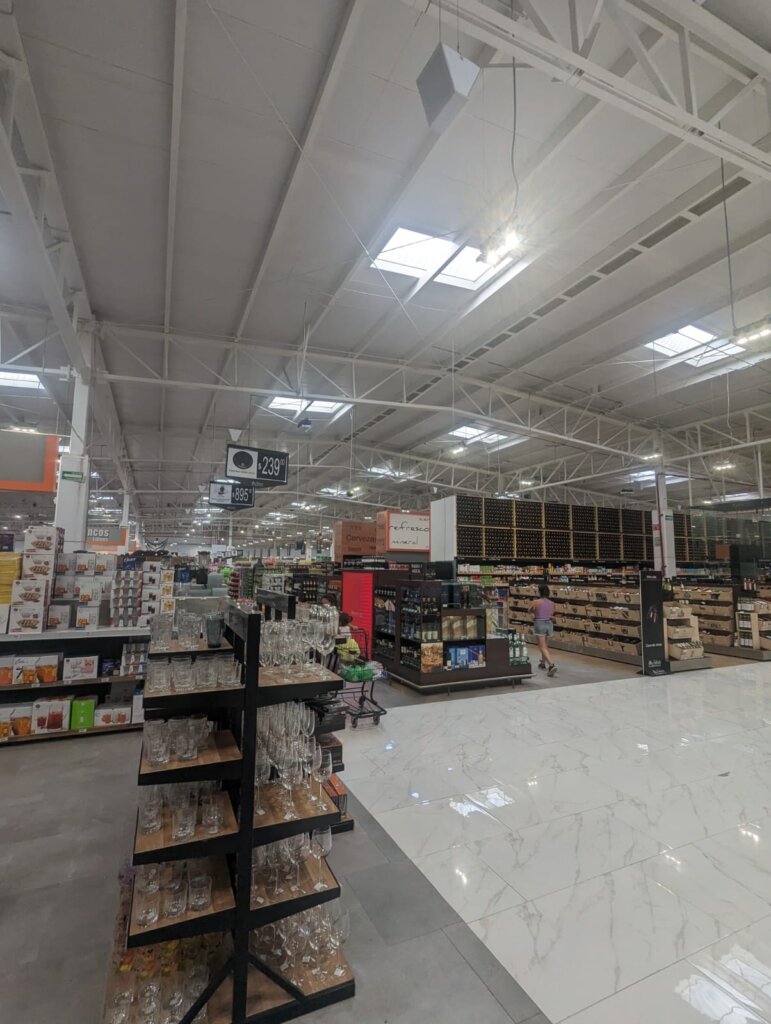
We spend the rest of the day chilling out and enjoying the flat.
A Day Off
Of the things to do in Tulum, there are two main ones. The archaeological site, and the cenotes (sinkholes full of water). We’ve researched the cenotes around us, and decide to save ourselves and our money. We’ll definitely do one with Hector and Sophie from Cancun, and the ones here are highly priced and apparently over-rated. This means we have a day to do nothing! We decide to go back to the beach we found yesterday, but better prepared this time, and going the direct route rather than the scenic route, to maximise on time.
The direct route still somehow takes us twice as long as Google thinks it should. We know that not having brakes means we go slower than we would normally, but we didn’t think it would slow us down this much! This means we arrive, once more, at the same time as all the tour groups. Except this time we’re coming in via the main entrance, and leaving them to enter the ruins whilst we get to skip at least that line. What yesterday was a woman taking our money and slapping wristbands on us is now absolute carnage. There’s touts everywhere selling tickets to this, that, hawkers with poor caged monkeys and iguanas luring you to take photos, street performers, shops, even a Starbucks, and of course, hoards of tourists. No ticket booth though! No sign for one either! We once more divide and conquer where I join the queue and James hunts out a park ticket office.
As I wait in the queue, I overhear a guide explaining that this park fee goes towards the maintenance and protection of a new park that has been constructed to ‘compensate’ for the destruction of nature needed to build the new trainline that will connect Tulum to Cancun (and beyond). We’ve clearly arrived at the start of the end of the government’s huge investment in tourism in this area to be ready once the train-loads of tourists start coming, but development in the rest of Tulum is clearly picking up speed. As with a lot of environmental issues, there’s no black or white. The train will destroy a lot of nature, but it will also (hopefully) reduce the demand on planes, cars, buses or shuttles polluting the area (although they have also built a new international airport here though too). Considering how much land-transport we see stopped still with engines running, blasting out fumes, I can’t help but lean towards any mode of transport that isn’t powered by fossil fuels. I have to say though, the investment seems to be being done well, with some actual forward planning and big-picture consideration, rather than just building things piecemeal like so many governments.
Part of the new development:

By this point, I’ve gotten to the front of the queue and James is still nowhere to be seen. I wait to the side as the already braceleted masses file in, stopping only for their plastic bottles to be confiscated and thrown into a giant pile that won’t get recycled. But at least it won’t enter the park! Sigh.
By the time James finds me with entry bracelets in hand, the queue dwellers think people in the same situation as us are jumping the line, my socially-awkward-anti-rule-breaking-nightmare. As luck would have it, a huge group of people get to the front and realise they don’t have the bracelet they need, and in this kerfuffle James and I slip in. Apparently in James’s queue there were people who already had the bracelets not realising that wasn’t the queue for the archaeological site. As with yesterday, hilarious oversight.
The time we saved cycling the direct route was totally eaten up by this chaos and also added so much extra unnecessary stress to what was a lovely bimble on the bikes up to that point. We enjoy cycling passed queue chaos part two for the archaelogical site and make it back to paradise beach. And relax.
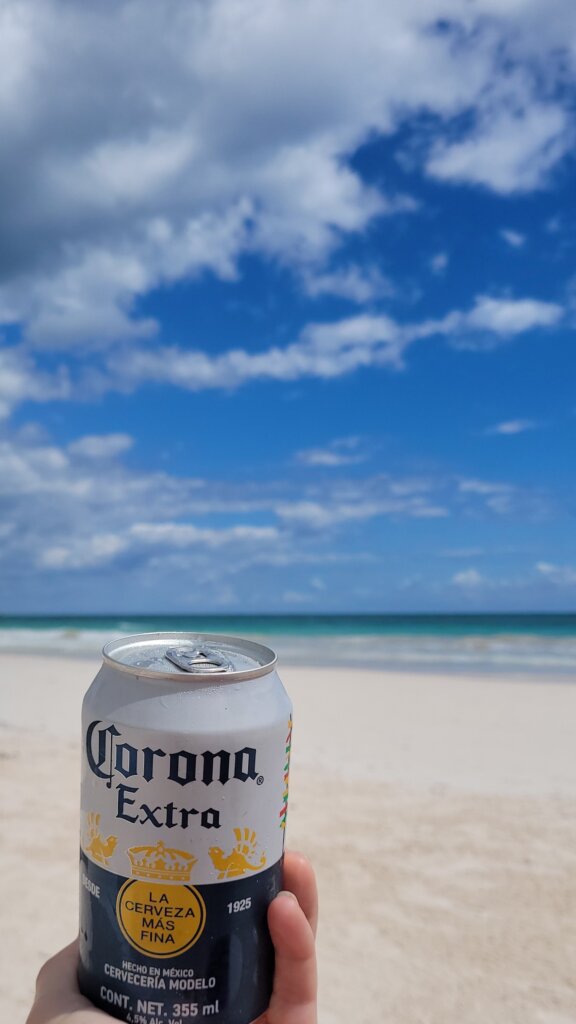
At one point, two quad bikes with four jungle-camo military men burdened with huge guns roll up just down the beach from us. I’ve been told the military presence in Quintana Roo (the tourist district up in the Yucatan peninsula) is meant to reassure tourists. It does the opposite for me. Thankfully they move on after a bit, and I can relax, enjoying the clouds rolling over and giving respite from the sun. We enjoy a read, paddle and swim in this slice of paradise. Serious bliss.

It’s gorgeous here, but we’re conscious of the sun on our skin, so we head back for lunch and also enjoy our lovely flat some more, by watching a film on the big-screen TV. Not on our phones! Simple things. The rest of the evening is spent just chilling out, testing our resilience in the ‘cold plunge pool’ and discussing what we’d put in our dream home from here (almost all of it).
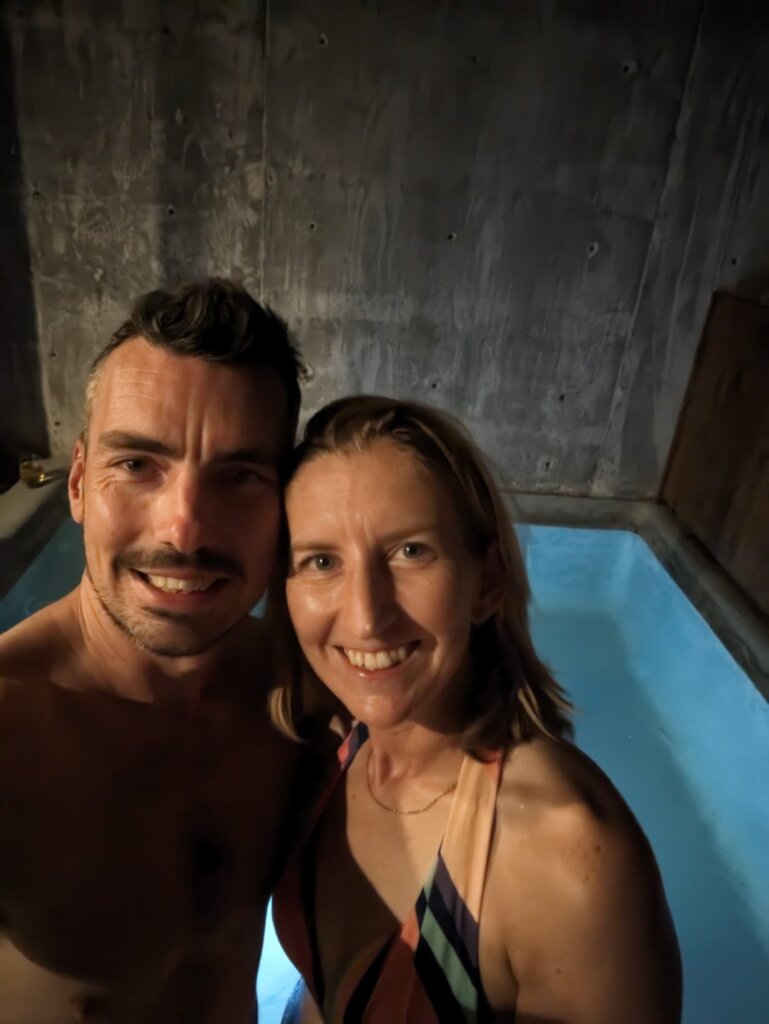
The War On Dogs
It’s check-out day of this little slice of ‘cool’ and also Tulum as we’re to head north to Cancun to meet up with Hector and Sophie. But first… It’s time for a run! We haven’t had a run since Lake Atitlan in Guatemala, and Hector is training for the London marathon, so we best check everything is still working before joining him in a training run!
We’ve mapped out a quick 5k loop and head off… straight into a wall of barking dogs. The road doesn’t go anywhere else, so we try and boldly walk through, but they seem to be riling each other up and getting closer and closer to us. We’ve been barked at by many a dog on an attempted run, but this has been the worst and closest they’ve been. We give in, the dogs win this round, we sheepishly and frustratedly turn back.
It’s actually a blessing we went that way because if we’d looped the other way, we would have been stuck the wrong side of the wall of dogs and had to go the whole loop back on ourselves. Thankfully, this way we know to do an out and back. We only encounter one more angry dog on the way, but without the pack, it is content with having done its job as we continue to run away from whatever it is it’s protecting. This is something we really will not miss about Latin America, but there’s plenty else we will.
We say bye to the flat of dreams with a plunge in the pool, a sun-dappled-through-leaves shower, and a pasta breakfast (every peso counts).
Off to Cancun!

**************
Adventure – exploring Tulum by bike on actual bike lanes making it really fun and a relaxing way to get around (for the most part). Swimming in the turquoise sea looking at the magnificent limestone ruins clinging to the cliffs.
Excitement – the path opening up to paradise beach. Trying my new ‘lava heat’ hot sauce I bought in Belize (James only). Using our chilly plunge pool after our run.
Trauma – the wall of dogs. Ticket chaos. Navigation woes. Cooking in a tiny kitchen with no chopping board.
